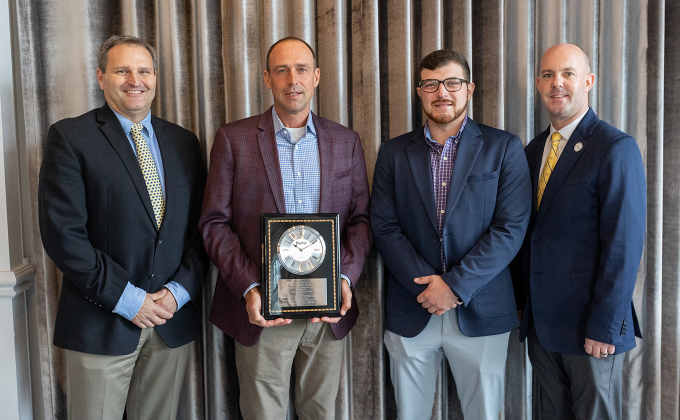Noyac Honored at Green Chair Education Series
Noyac superintendent Brian Goleski and assistant Ryan Bain (center, L-R) accept the Arthur P. Weber Environmental Leaders in Golf Award, pictured with MetGCSA executive director Mike McCall (L) and MGA director, member services Kevin Kline (R).
ELMSFORD, N.Y. (March 29, 2024) – The MGA’s annual Green Chair Education Series took place on Thursday at Alpine Country Club in Demarest, N.J. The program serves as part of the year-long education series sponsored by the MGA Foundation. It welcomes industry experts to share and present on relevant industry topics for attendees that include superintendents, green chairs, and other club officials.
The awarding of the MGA Arthur P. Weber Environmental Leaders in Golf Award stands as a highlight of the day, with the 18th presentation of the honor going to Noyac Golf Club in Sag Harbor, N.Y. The award goes to a club distinguished in environmental leadership and is named after former MGA President Arthur P. Weber. Weber wrote an Environmental Code of Conduct for golf course maintenance for his home club of Old Westbury Golf & Country Club which is still used today.
Related: Photos | Presentation Videos
Noyac superintendent Brian Goleski and assistant Ryan Bain were on hand to accept the award. Goleski and his team have exemplified environmental stewardship through a variety of actions, including converting two acres of unused land to a native area beneficial to the Peconic Land Trust and the formation of wildlife habitat. Deer and eagles are often seen around the club grounds, while such habitats also help pollinators like bees to thrive. The club has also improved its water efficiency and done its part in helping improve the quality of the waters in the nearby Peconic Bay, where Goleski grew up catching scallops and oysters. The club also emphasizes environmental education for its interns and assistants, ensuring they continue important stewardship practices in the future.
“The constant goal is to be part of a solution and not part of the problem,” said Goleski when accepting the award. “One club can impact a small area, so if every club does their part to run an environmentally friendly operation, the golf industry can be looked upon in a positive light.”
Presentations began with Brian Gietka, a Mid-Atlantic agronomist with the USGA Green Section. Gietka discussed the importance of making time for and prioritizing cultural practices that are integral to producing good turf. While these types of programs may inhibit play at times, they are crucial for the long-term health of golf courses and the goal to provide players with top-notch conditions. Gietka shared insight on operations such as aeration, topdressing, and more, while also discussing the importance of communication with golfers through the processes.
Robert Nielson, longtime superintendent at Bedford Golf & Tennis Club in Bedford, N.Y., who earned the Weber Award last year, followed by sharing newly implemented regulations and what they could mean for local golf courses. He also discussed bills that are currently working their way through the regulatory process and their potential impacts.
Garrett Bastardi, president of T3 (Turf Threat Tracker) and co-founder of UmbrellaWx closed the opening session of presentations, discussing how weather impacts course conditions as well as superintendents’ jobs. He shared how different weather conditions and patterns impact conditions in both short and long-term periods and how it impacts daily and long-term decision making for superintendents.
Following the presentation of the Weber Award, golf course architect Jim Nagle spoke to the crowd about renovations and restorations. Nagle, a member of the American Society of Golf Course Architects who recently launched Nagle Design Works after 25 years with Forse Design, shared a timeline of trends in golf architecture, including the rise in restorations in recent decades. He also shared valuable information for those embarking on such a project, from how to select an architect and setting a priority list for the project to how to educate members on the importance of the plan and its implementation.
The day’s programming concluded with a lightning round by Elliott Dowling, regional director of the East region for the USGA’s Green Section. Dowling covered a variety of his most-frequently discussed topics from course consulting visits and interactions with superintendents over the last year. Dowling shared insight on many topics including aeration timing and methods, native grass selection and placement, tree management, and construction and renovation trends.
For more information about the Green Chair Seminar, please contact the MGA's Member Services Department.
